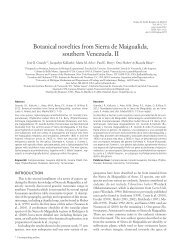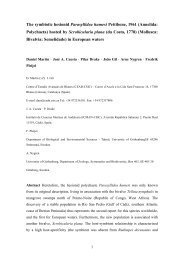PhD Thesis MJProl .pdf - digital-csic Digital CSIC - Consejo Superior ...
PhD Thesis MJProl .pdf - digital-csic Digital CSIC - Consejo Superior ...
PhD Thesis MJProl .pdf - digital-csic Digital CSIC - Consejo Superior ...
Create successful ePaper yourself
Turn your PDF publications into a flip-book with our unique Google optimized e-Paper software.
New strategies for the control of bacterial infections in marine fish larval rearing 17<br />
aquaculture (Moriarty, 1998; Rengpipat et al., 2003) might partly be due to inactivation<br />
of QS molecules, apart from the production of antagonistic substances (Dong et al.,<br />
2000, 2004; Molina et al., 2003). A direct immunomodulatory activity was produced in<br />
several mammalian systems by a QS molecule from Pseudomonas aeruginosa (Hooi et<br />
al., 2004; Ritchie et al., 2005; Thomas et al., 2006).<br />
The importance of QS in situ gene expression regulation is becoming more evident<br />
for pathogenic bacteria but hardly for putative probiotic bacteria. Some problems could<br />
arise, such as the development of resistances (Zhu et al., 1998) or lack of specificity, as<br />
not all bacteria found to contain QS systems are pathogens. Therefore, there is a need to<br />
know more about the importance of QS molecules on their in vivo metabolism and their<br />
interaction with the non-pathogenic microbial community and with the host.<br />
1.2.2. Acting on host-microbe interactions<br />
• Immunostimulants<br />
Fish are intimately in contact with a complex and dynamic microbial world, and a<br />
large fraction of these microbes cling to and colonize epithelial surfaces. In rare<br />
circumstances microbes cause disease, either directly, by damaging or traversing<br />
epithelial layers, or indirectly, by inducing tissue-damaging inflammatory responses. If<br />
microbial pathogens invade the host, innate and adaptive defence mechanisms are<br />
activated for preventing further spread of the infection (Gómez and Balcázar, 2008).<br />
The fish immune system possesses two integral components:<br />
i) The innate, natural or non-specific defence formed by series of cellular and<br />
humoral components.<br />
ii) The adaptive, acquired or specific immune system characterized by the<br />
humoral immune response through the production of antibodies and by the<br />
cellular immune response mediated by T-lymphocytes.<br />
However, it is believed that larvae do not have the ability to develop adaptive<br />
immunity during the early stages of development. In this regard, the innate immune<br />
system is probably the major defence against microbes (Vadstein, 1997). These

















